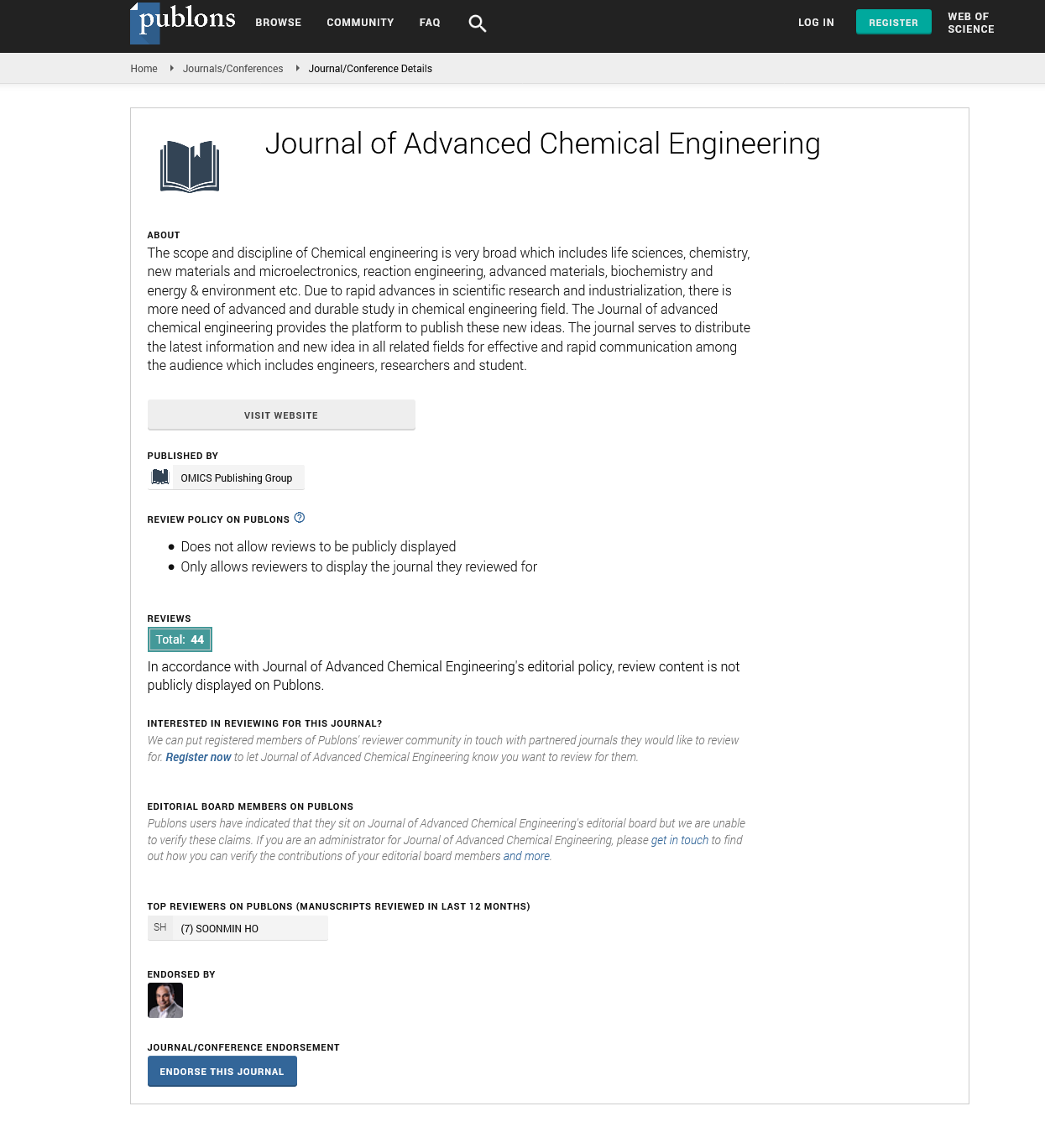Indexed In
- Open J Gate
- Genamics JournalSeek
- Smithers Rapra
- RefSeek
- Directory of Research Journal Indexing (DRJI)
- Hamdard University
- EBSCO A-Z
- OCLC- WorldCat
- Scholarsteer
- Publons
- Geneva Foundation for Medical Education and Research
- Google Scholar
Useful Links
Share This Page
Journal Flyer

Open Access Journals
- Agri and Aquaculture
- Biochemistry
- Bioinformatics & Systems Biology
- Business & Management
- Chemistry
- Clinical Sciences
- Engineering
- Food & Nutrition
- General Science
- Genetics & Molecular Biology
- Immunology & Microbiology
- Medical Sciences
- Neuroscience & Psychology
- Nursing & Health Care
- Pharmaceutical Sciences
Opinion - (2022) Volume 12, Issue 10
Hazardous Effects of Petrochemical Industries: Systems Study of the Petrochemical Industry
Lee Minhooo*Received: 07-Oct-2022, Manuscript No. JACE-22-18870; Editor assigned: 10-Oct-2022, Pre QC No. JACE-22-18870; Reviewed: 28-Oct-2022, QC No. JACE-22-18870; Revised: 03-Nov-2022, Manuscript No. JACE-22-18870; Published: 11-Nov-2022, DOI: 10. 35248/2090-4568.22.12.255
Description
The modern petrochemical industry is the result of decades of unresolved economic, technological, and political forces. It is hoped that this complex industrial system has evolved into an efficient and adaptable provider of economic needs. They seek to identify the industry's strengths and weaknesses, as well as opportunities for further development. The necessary insight is provided by an industry systems model.
A criterion of efficient feedstock utilisation on the industry model replicates the dominant structure of the actual industry, lending credibility to the model and the performance criterion. Fourteen of the twenty chemicals for which current production practises differ from those proposed by the model are currently being researched. In the model, the remaining six chemicals are produced by currently obsolete processes that could be revived. The response of the validated model to scenarios of potential future developments provides points of departure for planning the industry's long-term development.
Energy efficiency evaluation is widely used in complex petrochemical industries as the most effective indicator for energy savings and emission reduction. Combining traditional mechanism methods based on momentum transport, energy transport, quality transport, and reaction engineering (RG) (TTRG) with data-driven artificial intelligence methods is now common. Using a combined method to achieve production optimization and energy savings by analysing energy efficiency evaluation indicators has gradually become an important part of complex petrochemical industries. As a result, this paper introduced the main methods and most recent research findings for evaluating energy efficiency in complex petrochemical industries. These methods are broadly classified into three categories: mechanism methods based on TT-RG, data-driven artificial intelligence methods, and hybrid methods combining mechanism and data-driven. The various methods are then compared and described in detail. Furthermore, the best method for evaluating energy efficiency can be identified in order to provide theoretical guidance for energy savings and emission reduction in complex petrochemical industries. Finally, the future development direction for evaluating energy efficiency in complex petrochemical industries is provided.
Petrochemical industry hazards
Although petrochemicals provide numerous useful products, they can also be harmful to human health and the earth's ecosystem. When most of these chemicals are released into the environment, they can have negative effects such as air, water, and soil pollution. Petrochemical aromatic compounds are significant environmental pollutants that can enter the environment via natural oil seeps, industrial waste products and emissions, oil storage wastes, accidental spills from oil tankers, coal tar processing wastes, petrochemical industrial effluents and emissions, and so on. The petrochemical industry is a significant source of the primary greenhouse gases that cause global warming. Other environmental effects include ozone depletion, acid rain, air pollution, and so on. Potentially hazardous substances in the petrochemical industry can be noxious, foulsmelling, or combustible. Noise pollution is associated with headaches, annoyance, uneasiness, stress, impatience, displeasure, hypersensitivity, extreme anxiety, anger, endangerment, and violence in areas near petrochemical industries.
Soil contamination may occur as a result of residuals from refining processes such as some hazardous wastes, catalysts or coke dust, tank bottoms, and sludge from treatment processes. The petrochemical industry may also result in biodiversity loss and ecosystem destruction Petrochemical industry effluents contain a high concentration of polycyclic and aromatic hydrocarbons, phenols, metal derivatives, surface-active substances, sulphides, naphthylenic acids, and other chemicals. Toxic products present in effluents accumulate in water bodies due to inefficient purification systems, resulting in water pollution that is fatal to both aquatic and human life. Petrochemical exposure can occur in a variety of ways; they can be absorbed through the skin or ingested. They can also have an impact on human life by accumulating in tissues/organs and causing brain, nerve, and birth defects, cancer, asthma, and hormonal imbalances. Chronic effects of exposure include skin irritation, ulcers, and allergic dermatitis.
Citation: Minhooo L (2022) Hazardous Effects of Petrochemical Industries: Systems Study of the Petrochemical Industry. Adv Chem Eng. 12:255.
Copyright: © 2022 Minhooo L. This is an open-access article distributed under the terms of the Creative Commons Attribution License, which permits unrestricted use, distribution, and reproduction in any medium, provided the original author and source are credited.

